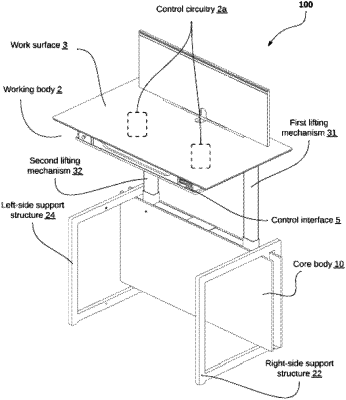| CPC A47B 9/20 (2013.01) [A47B 9/04 (2013.01); A47B 21/02 (2013.01); A47B 21/04 (2013.01); A47B 2200/0058 (2013.01); A47B 2200/0062 (2013.01); A47B 2200/0084 (2013.01)] | 16 Claims |

|
1. A desk configured to be positioned for a user in a sitting position and/or a standing position, the desk having a rear side, a left side, and a right side as viewed by the user, wherein the desk comprises:
a working body that provides a work surface of the desk, wherein the work surface is disposed at a current height, wherein the current height is adjustable;
a left-side support structure disposed at the left side of the desk, wherein the left-side support structure supports at least part of the desk, and wherein the left-side support structure is stationary during adjustments of the current height of the work surface;
a right-side support structure disposed at the right side of the desk, wherein the right-side support structure supports at least part of the desk, and wherein the right-side support structure is stationary during the adjustments of the current height of the work surface;
a core body disposed vertically at the rear side of the desk, wherein the core body is coupled to the left-side support structure and coupled to the right-side support structure, wherein the core body houses at least part of one or more lifting mechanisms, wherein the core body is stationary during the adjustments of the current height of the work surface except for the one or more lifting mechanisms; and
a control interface configured to receive user input from the user; and control circuitry configured to:
(i) detect the user input received by the control interface; and
(ii) responsive to detection of the user input, control the one or more lifting mechanisms to either (a) lift the working body and increase the current height of the work surface, or (b) lower the working body and decrease the current height of the work surface.
|